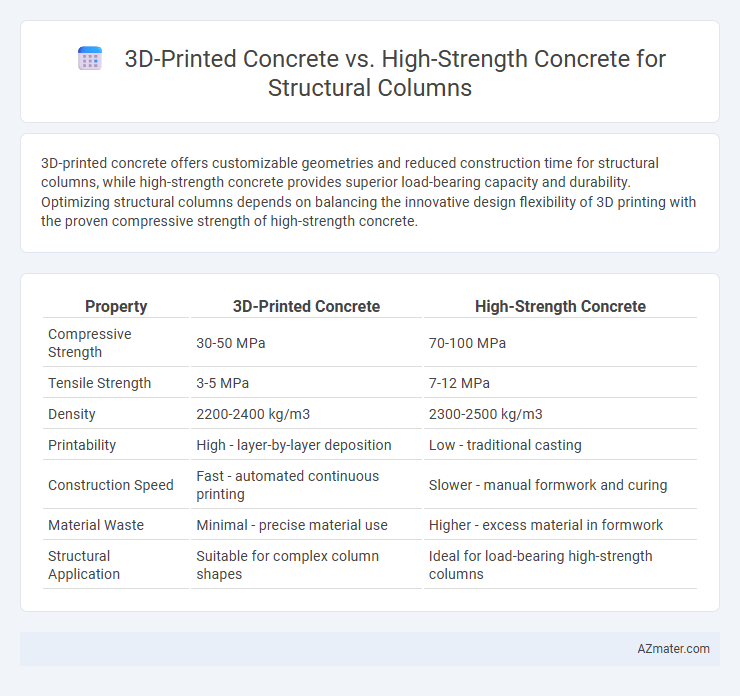3D-printed concrete offers customizable geometries and reduced construction time for structural columns, while high-strength concrete provides superior load-bearing capacity and durability. Optimizing structural columns depends on balancing the innovative design flexibility of 3D printing with the proven compressive strength of high-strength concrete.
Table of Comparison
| Property | 3D-Printed Concrete | High-Strength Concrete |
|---|---|---|
| Compressive Strength | 30-50 MPa | 70-100 MPa |
| Tensile Strength | 3-5 MPa | 7-12 MPa |
| Density | 2200-2400 kg/m3 | 2300-2500 kg/m3 |
| Printability | High - layer-by-layer deposition | Low - traditional casting |
| Construction Speed | Fast - automated continuous printing | Slower - manual formwork and curing |
| Material Waste | Minimal - precise material use | Higher - excess material in formwork |
| Structural Application | Suitable for complex column shapes | Ideal for load-bearing high-strength columns |
Introduction to Structural Columns
Structural columns serve as critical load-bearing elements designed to transfer building loads from roof and upper floors to foundations safely. 3D-printed concrete introduces precise layering and complex geometries with reduced material waste, while high-strength concrete offers superior compressive strength typically exceeding 50 MPa for enhanced load-carrying capacity. Comparing these materials involves evaluating printability, durability, and mechanical performance specific to structural column applications in modern construction.
Overview of 3D-Printed Concrete Technology
3D-printed concrete technology utilizes additive manufacturing to layer material precisely, enabling complex geometries and reduced material waste compared to traditional high-strength concrete. This method incorporates specialized mix designs with enhanced flowability and rapid setting times to ensure structural integrity during printing. It offers potential for faster construction and customization in structural columns while maintaining comparable strength characteristics to conventional high-strength concrete.
High-Strength Concrete: Properties and Applications
High-strength concrete (HSC) exhibits compressive strengths typically above 6,000 psi (41 MPa), offering superior load-bearing capacity and durability for structural columns compared to conventional concrete. Its low permeability and enhanced resistance to chemical attacks make HSC ideal for high-rise buildings, bridges, and infrastructure exposed to harsh environments. Advances in mix design involving silica fume, fly ash, and superplasticizers optimize HSC's mechanical properties and workability, ensuring structural reliability and extended service life.
Material Composition and Mix Design Differences
3D-printed concrete for structural columns incorporates a mix design optimized for extrudability and rapid setting, often using additives like viscosity modifiers, accelerators, and fibers to enhance layer adhesion and shape retention, contrasting with high-strength concrete's traditional blend of high cement content, silica fume, and low water-cement ratio aimed at maximizing compressive strength. The material composition in 3D-printed concrete typically includes fine aggregates and controlled rheology admixtures to ensure pumpability and buildability in a layer-by-layer process, while high-strength concrete focuses on achieving dense microstructure and durability through optimized aggregate grading and chemical admixtures. These fundamental differences in mix design reflect the need for 3D-printed concrete to balance printability with structural performance, whereas high-strength concrete prioritizes load-bearing capacity and long-term durability.
Structural Performance Comparison
3D-printed concrete demonstrates comparable compressive strength to high-strength concrete in structural columns, with values often exceeding 50 MPa, while providing enhanced geometric flexibility and reduced material wastage. High-strength concrete typically offers superior tensile strength and well-documented durability characteristics due to its dense microstructure and optimized mix design. However, 3D-printed concrete exhibits anisotropic behavior influenced by layer adhesion, which can affect load distribution and requires tailored reinforcement strategies for structural stability.
Durability and Longevity Factors
3D-printed concrete exhibits enhanced durability through precise layer bonding and reduced voids, minimizing crack propagation compared to traditional high-strength concrete. High-strength concrete offers proven long-term performance under heavy loads due to its dense microstructure and superior compressive strength. However, 3D-printed concrete's customizable mix and curing methods enable tailored resistance to environmental degradation, potentially extending the structural column's longevity beyond conventional materials.
Construction Speed and On-site Efficiency
3D-printed concrete significantly accelerates construction speed by enabling layer-by-layer deposition without formwork, reducing labor-intensive processes and minimizing human error. High-strength concrete, while offering superior load-bearing capacity, typically requires conventional casting and curing times that slow overall project timelines. The on-site efficiency of 3D-printed concrete stems from its automation and precision, which optimize material usage and streamline workflow compared to the more labor-dependent procedures of high-strength concrete.
Cost Analysis and Economic Considerations
3D-printed concrete significantly reduces labor and formwork costs compared to traditional high-strength concrete used in structural columns, offering up to 30% savings in overall construction expenses. Material efficiency in 3D printing minimizes waste and allows for complex geometries without additional cost, whereas high-strength concrete demands more rigorous quality control and curing time, increasing overhead. Despite higher initial equipment investment, 3D-printed concrete demonstrates greater long-term economic advantages through faster construction cycles and lower material usage.
Sustainability and Environmental Impact
3D-printed concrete significantly reduces material waste and lowers carbon emissions by enabling precise layering and minimizing formwork in structural columns. High-strength concrete, while offering superior load-bearing capacity, often involves higher cement content, contributing to increased CO2 emissions and greater environmental impact. Sustainable construction favors 3D-printed concrete innovations due to its potential for resource efficiency and reduced ecological footprint in column fabrication.
Future Prospects and Innovations
3D-printed concrete offers significant future prospects in structural column construction through its potential for complex geometries and reduced material waste, driven by advancements in digital fabrication and material science. Innovations such as enhanced printable mix designs and integrated reinforcement systems aim to improve mechanical properties to rival those of traditional high-strength concrete, which remains the benchmark for load-bearing capacity and durability. Continued research on hybrid construction methods and real-time monitoring technologies is poised to bridge performance gaps, promoting wider adoption of 3D printing for sustainable and resilient structural columns.

Infographic: 3D-printed concrete vs High-strength concrete for Structural column
 azmater.com
azmater.com